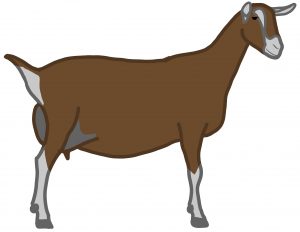Toggenburg
History
The Toggenburg originated in Switzerland where its breeding was strictly regulated for purity and type. It was widely exported and has a presence in many countries, including Australia, Great Britain and the United States of America. When imported into Britain the Pure Toggenburg was maintained by some breeders while others used selective outcrossing to develop a larger animal. Where the Pure Toggenburg had a short, dished face and well developed fringes of hair the British Toggenburg had shorter hair and a longer face. It also had more colour variation, ranging from light fawn to dark chocolate.
Between 1947 and 1953 Australia imported six bucks and fourteen does, some in kid. Six more bucks and three does were born from these does. Of these imports, four were Pure, while the remainder were British Toggenburgs. The major importer was the New South Wales Department of Agriculture’s State farm at Condobolin. They bred considerable numbers and dispersed Toggenburgs throughout Australia.
The breed’s robust nature makes it a hardy goat able to look after its best interests. It prefers temperate regions but is found in all climates, with its dark skin providing good protection against skin cancer.
Breed standard
GENERAL APPEARANCE (style & quality):A robust dairy type of animal, active and vigorous, showing breed character and vitality, well proportioned. Any tendency to raciness or legginess is undesirable. Does feminine, bucks obviously masculine in appearance.
HEAD (skull, eyes, ears, mouth, nostrils):Head medium length, facial line straight, polled or neatly disbudded. Eyes set well apart, full and bright. Ears erect and pointing slightly forward. Muzzle broad and strong, but without coarseness. Side profile should show no tendency to undershot or overshot jaw.
NECK:Clean at junction with head and blended smoothly into shoulders, with or without tassels. Does long and fine, but not too slender. Bucks fine and strong, not coarse.
BACKLINE:Back strong, straight and horizontal to hips.
FOREQUARTERS:Fine withers, with shoulders sloping and blending into body. Chest full between the forelegs, deep in bucks, fairly deep in does.
BODY (barrel):Length of barrel proportionate to height. Rib cage well rounded, large, deep and a wedge shaped body.
HINDQUARTERS:Gradual slope from hips to tail, good width between hips and between thurls. Rump broad and strong, pin bones wide and prominent.
LEGS (hooves):Well boned, strong, straight and parallel (not cow hocked). Hocks slightly bent when seen from side. Strong in pasterns. Hooves sound and well-shaped.
UDDER:Carrying well up the back and broadly attached with good fore development. Not pendulous or unduly divided, showing good capacity. Skin: colour fawn to dark brown and softly textured.
TEATS:Of adequate size for ease of milking, well attached and distinct from udder. Set well apart, pointing slightly forward and down not outward.
TESTICLES:Scrotum well attached relatively even and not divided or unduly penduIous, carrying two testes.
RUDIMENTARY TEATS:Two, set wide apart slightly to the fore and side of the scrotum, of good size but not overdeveloped, unless the buck is milking.
SIZE (height):Does 79cm (31 inches). Bucks 90 cm (35.5 inches).
COAT:Does and Bucks to have a short coat, a short coat with longer fringes, or a long coat all over.
COLOUR:Light fawn to chocolate (with no preference for any shade) with white Swiss markings as follows – facial stripes from above the eye to the muzzle, edges and tips of ears, legs from the knees and hocks down to hooves and insides of legs to trunk, on rump and around tail. Spots at base of tassels or on neck in place of tassels. Facial stripes may be indistinct in mature bucks.
DIFFERING FROM IDEAL (found and recognised):Cream or fawn instead of white markings. White hairs throughout coat. White spots on head or throat. Indistinct facial markings. White ears. Raised bridge to nose or dished facial line. Horned. Uneven tassels.
FAULTS:Spots on barrel smaller than a 10cent coin. Steeply sloping rump. Cow hocks. Dropped pasterns. Roach back or sway back. Size differing substantially from ideal. Uneven gait. Pink skin. Poor feet. Splayed feet. Low set ears. Weak or narrow chest. Shallow body. Lack of dairy quality. Fleshy penduIous or unduly divided udder. Pocket in udder. Teats: small, thin, large bulbous, ill-defined, unbalanced. Lack of milking capacity. Lack of masculinity in bucks. Divided, uneven or unduly penduIous scrotum.
DISQUALIFICATIONS:Obviously undershot or overshot jaw (side profile). Black or rusty black coat colour. Double teats. Double orifices. Supernumerary teats. Intersex. Lack of characteristic Swiss markings. Wry face. Undescended testicles in bucks or one testicle only. Pendulous ears. White or cream belly. Patches on barrel larger than a 10cent coin.

